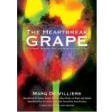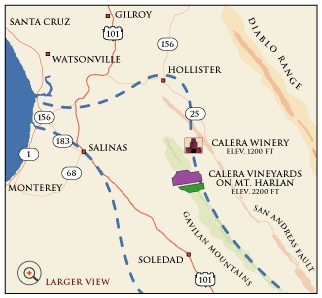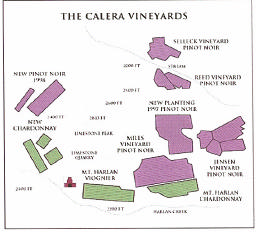Calera: Pinot Grows Where Limestone Flows
With its 2005 vintage wines, some of which have been released, Calera Wine Company is celebrating its 30th
vintage. In 1975, when Josh Jensen first planted his vines on a remote property in the Gavilan Mountains, he
was among a select few pioneers at the time who were attempting to farm Pinot Noir in California. Dick Graff
had preceded Jensen by ten years at Chalone, located just north of Calera in the same Gavilan Mountain Range
in San Benito County. Others included Richard Sanford in Santa Barbara County (Sanford & Benedict Vineyard),
David Bruce and Merry Edwards (Mt Eden) both in the Santa Cruz Mountains, Joseph Swan, Bob Pellegrini
(Olivet Lane) and Joe Rochioli, all in the Russian River Valley, Tony Husch in the Anderson Valley, and
Francis Mahoney (Carneros Creek) in Carneros. As it would turn out, despite the diversity of microclimates
each grower settled on, all of them proved quite successful. There was only one innovator (other than Graff at
Chalone - see * note at end on page 6), however, who based his whole success on limestone which was rarely
found in California soil in areas appropriate for viticulture. A student and fervent lover of Burgundy, Jensen was
convinced that it was the limestone in the soil in Burgundy that made the wines so special. Jensen has said,
“Here in this country, the establishment doesn’t think limestone is important. I didn’t waste my time debating
it. I just saw where the great Burgundies grow and decided to let my wines do the talking.”

Josh Jensen’s remarkable story was first told in detail in 1993 in the first edition of the
book, The Heartbreak Grape, A Journey in Search of the Perfect Pinot Noir, by Marq de
Villiers. A completely revised and updated version was published in 2006 (McArthur
& Company, paperback, $10.99) and is the source for much of the information to follow
in this feature article. A lot has changed since Jensen released his first Calera Pinot
Noir in 1978. As Tim Patterson remarked last year, “Pinot Noir is no longer the heartbreak
grape. But it does still have a mind of its own.” Jensen’s saga is an inspiration
for anyone hoping to follow a passion for Pinot Noir and only now, after thirty-two
years has his heartbreaking efforts found vindication. Pinot Noirs from California, and
in particular those from Calera, can hold their own to the best from Burgundy.
Josh Jensen’s father was a dentist, and it was another dentist friend, Dr George Selleck, a prominent wine enthusiast,
who first introduced Josh to wine. After college at Yale, Jensen attended Oxford, where he obtained a
degree in anthropology, A very unlikely precursor to a life committed to winemaking, but Jensen drank wine
daily at Oxford and acquired a special love for Burgundy. He also had some ability to speak French, and in the
summer of 1969 traveled to Domaine Romanee-Conti and applied for a job as a picker. The next year he was
hired by André Noblet, who was in charge of the Domaine. The following year he worked the harvest at
Domaine Dujac, where he struck up a close friendship with Jacques Seysses. When he returned to California in
1973, he was focused on producing fine Pinot Noir. It was a gamble, for sure, and he was the first to admit it in
later years. “In my case, I just gambled. Pinot Noir was immensely unfashionable when I started. I was young enough that I didn’t realize I couldn’t do it, so I just did it. I was too dumb to realize I couldn’t.”

For two years, he searched California for a site that combined
limestone soils and a suitable climate for growing Pinot Noir. In
1974, he purchased 324 acres at 2,300 feet elevation in the
Gavilan Mountains for $18,500. The land was originally owned
by the S.H. Powell Co. mining operation which had at one time
quarried large amounts of limestone there. This was about as
unlikely a spot to grow Pinot Noir as one could find. It was extremely
isolated, with no paved roads. Jensen actually owned no
land that provided access to the property until 1982 when he
purchased an adjacent property which also had limestone and a
water supply. Most of the property consisted of steep hillsides,
there was no electrical power and no telephone lines. It was
located on what the United States Geographical Survey termed
’the central creeping zone’ of the San Andreas Fault. The remote area was alive with rattlesnakes,
rabbits, gophers, deer, wild pigs and squirrels. What it did have, however, was a suitable climate for
growing Pinot Noir. Fog rolled in frequently from the neighboring valleys creating warm days and
cool nights. The potential for very long growing seasons was the result and, in fact, Calera often
harvests well into October, after both Carneros and Sonoma. The soil was poor in nutrients, but it did
have plenty of limestone.
With the cash infusion from his partners, his father and William Garrard Reed (a successful businessman),
he set out to build a winery out of an old rock crushing plant on the property and establish vineyards
on the hillsides further up the mountain. Jensen chose the name Calera, which is Spanish for lime kiln,
referencing the old lime kiln left on the land when he acquired it. He moved onto the property with his
wife and two children and lived there in a 10 ft by 60 ft mobile home for over four years. In 1975, he
cleared enough land to plant the initial three Pinot Noir vineyards, located approximately a 50-minute
drive from the winery site. The vineyards were Jensen (named after his father, Stephen), Selleck
(named after Dr George Selleck who first introduced him to wine), and Reed (after his initial business
partner). Mills (named after John Everett Mills who built the infrastructure on the property on Cienaga
Road for a mining operation - these retaining walls were to become part of Calera’s gravity-flow
winery), and the Chardonnay and Viognier plantings followed in 1984. The Jensen Vineyard is nearly
14 acres, Reed is 4.4 acres, Selleck is 4.8 acres, and Mills is 14.4 acres. The most recent Pinot Noir
planting is the Ryan Vineyard (named for Jim Ryan, the vineyard manager since Calera began) which
is 13.1 acres and was planted in 1998 and 2001. Currently, there are some unnamed plantings of
Pinot Noir which has not produced commercially-viable grapes as yet. Jensen feels that that are
probably locations on his property that may have an even better potential for Pinot Noir than his original
plantings.

The planting of the initial vineyards was a struggle. Water had to be crated uphill for irrigation.
Battling gophers and other animals was a full-time job. Mildew, leaf roll virus, leafhoppers, and oak
root fungus were constant threats.
It is not clear (Jensen isn’t saying) where exactly the original clones of Pinot Noir at Calera came from.
Selleck, Reed and two-thirds of Jensen are probably “suitcase clones” either directly from Domaine
Romanee-Conti or indirectly from Chalone. The rest of the plantings are presumably from nursery bench grafts
originating in California. The Mills Vineyard, Chardonnay and second planting of Viognier are own-rooted,
the rest of the plantings are grafted onto nursery rootstock.
By 2006, Jensen had 83.6 acres planted on his property which consisted of 648 acres (the first two
parcels purchased in 1974 and 1977) and 440 adjacent acres. The winery, the world’s first and only
completely gravity-flow winery, was built into a hillside on seven different levels. The first vintage of
estate Pinot Noir was in 1978, all of 700 cases in half-bottles, and was the initial Calera wine made at
the winery. Calera is the only winery in the Mt. Harlan AVA (he can also use the Central Coast AVA
and San Benito AVA designations as well). Curiously though, the vineyards are in the Mt Harlan AVA,
but the winery technically is not, so he cannot use “estate bottled” on the label.
Jensen has certainly had his struggles. Yields have been painfully low, with averages of about 1½ tons
per acre, with a number of vintages providing less than a ton per acre. Pinot Noir is notoriously difficult
to grow and Jensen was painfully aware of this. “We had vineyards producing a variety that was
considered impossible to do well in California then. We had people, even family and friends, saying
I’d lose my shirt and make a fool of myself over this.” He had to make zinfandel from acquired grapes
until 1985 to provide some cash flow. Fortunately, he retained control of his vineyards from the beginning
(only recently has he given parcels to his children) and assumed complete ownership of his winery
several years after his beginnings. His sold his first vintage, 1978, for $18.50 a half-bottle. By
1999, he had received many favorable reviews for his wines and the Calera Pinot Noirs were priced at
$80 a bottle. Despite this, the popularity of Calera seemed to languish in the following years with the wine press and public turning their
attention to newer and more fashionable cult producers. Sales suffered and he was forced to drop his price range for Pinot
Noir to $42 to $50 a bottle where it has remained to the present time.
The Calera Pinot Noirs are probably the closest to the Burgundian idiom of all Pinot Noirs in California.
The wines are shy and reticent upon release, with the best drinking window between 5 and 20 years
after the vintage. Jensen abhors what he calls “Smasher-Blasters,” California Pinot Noir fruit bombs
that “are mostly one-dimensional, simple but potent beverages that will merely lose their fruit, their
main if not their only appeal, with the passing years and just turn into …. expensive mud.” His vision
for the perfect Pinot Noir is well reflected in the eloquent style of his wines and is one “that is perfectly
balanced on the cusp of richness and complexity, of fruitiness and subtlety, and is neither one nor the
other.”

The first winemaker at Calera was Steve Doerner, a microbiologist who had never made wine. He
worked closely with Jensen until 1992 when he left for Cristom Estate in the Willamette Valley of
Oregon. Through the years, many future stars of the California winemaking industry spent time at
Calera learning from Mr Pinot (Josh’s moniker).
Calera’s winemaking regimen is as follows. The grapes since 1984 have not been de-stemmed
(except for some purchased grapes and grapes from young vines). No cold soak is employed. Typically,
tartaric acid is added, native yeasts are utilized for fermentation, punch downs are by hand, and
the wines undergo 100% malolactic fermentation in Francois Freres oak barrels. New oak is typically
30%. Racking is done twice into the fining tank (egg whites are used) and bottling tank. The single-vineyard Pinot Noirs are aged for 18 months prior to bottling.
Interestingly enough, the wines of Calera are widely distributed in the United States and universally
acknowledged as benchmarks for California Pinot Noir, yet Japan has the most avid fans for Calera
wines and where Calera has a cult following. A few years ago, a Japanese adult comic book or ‘manga’
featured a crime-fighting sommelier. In one episode, the hero is given a couple of wines to taste and
concluded the wine must be Domaine Romanee-Conti, only to recall at the last second that it could also
be Calera’s Jensen Vineyard Pinot Noir since it is the only other wine of similar character and quality in
the world. Robert Parker has been one of the most outspoken fans of Calera Pinot Noir. In 2003, Parker
tasted 64 Calera Pinot Noirs dating back to 1987 (eRobertParker.com, April, 2003). “Calera is one of
the most compelling Pinot Noir specialists, of not only the New World, but of Planet Earth. Credit must
be extended to its visionary founder, proprietor Josh Jensen. Ironically, today Jensen rarely gets the
acclaim that these wines merit.”
Noted wine critic and author, Oz Clarke, wrote in The New Classic Wines about the typicality of each of
the single vineyard Calera Pinot Noirs. “Jensen is the most open, with deliciously accessible flavors of
strawberry and honey, sometimes developing an almost candied sweetness which ages to a thrilling
combination of raspberry sauce richness, swished with the rasping perfume of leather. Reed has a
less dense style - combining the savory perfumes of roast coffee and earth with a fruit of blackberry
and the herbal aromas of sassafras. Selleck is denser in every way. More tannic, slower to evolve, but
magnificently perfumed, full of the classic Burgundian entangled mysteries of cherry and plum, wild
raspberry, toast and cinnamon spice. Mills exhibits that rarest and most haunting of perfumes - that of
violets.”
Josh Jensen’s comments are, of course, most valuable. “Jensen is a complex wine and for me consistency
of complexity is really the ultimate compliment to a Pinot Noir. Jensen is usually the most tannic
and also the leanest, the least rounded. It has some type of olive character, a spiciness, and … .well,
the well runs dry after saying those things. The Reed most years has to me a sort of chocolaty, raisiny
character. In personality, it has acquired a softness and precociousness. We release it first of the single-
vineyard wines. The Selleck is my personal favorite almost every vintage. It is also the fastest to
evolve (opposite of Clarke’s remarks!). It seems to have one more layer, one more bit of depth and
complexity than the others, and since that’s what I appreciate the most it appeals to me the most. The
Selleck is the most feminine of our wines, the most subtle. It seems to taste of spice, nutmeg, truffles
and earth together, and floral, so it is complete and complex. The Mills has terrific structure but it often
seems leaner than the other three. Compared to any other Pinot Noir from any other producer it is
rich, full-flavored, dark and complex. But compared to our own vineyards, it seems less rounded and
supple and fat by comparison.”
I recently tasted through several Calera single-vineyard Pinot Noirs as well as some white wines. I
must admit that I had veered away through the years, looking at many of the newer producers and failing
to follow an early inspiration I had. The first case of Pinot Noir I ever purchased was the 1985
Calera Jensen Pinot Noir which was one of my early Pinot epiphanies.
2005 Calera 30th Anniversary Vintage Mt. Harlan Aligoté
12.8% alc., 54 cases, $28. Aligoté (Al-eego-
tay) is the other white grape of Burgundy. Reportedly, its ancestral home is Bouzeron in Burgundy’s
Côte Chalonnaise. The grape is noted for producing an austere acidic wine and those in
Bouzeron were known to add a few drops of Créme de Cassis to the wine to make it palatable. This
was the origination of the cocktail Kir. Actually, if yields are kept low and the wine is vinified appropriately,
it can produce a white wine of crisp character. It is most adaptable to limestone-rich soils.
Jensen grafted over two rows of Pinot Noir to Aligoté in the Jensen Vineyard as an experiment. This is
the first commercial harvest and one of the few wineries to release this varietal in the United States.
·
I
rather enjoyed this wine. The flavors were similar in profile to Riesling with apple, mineral and a little
petrol evident. Tropical fruits and butter scents were quite attractive. The acid was well-corralled.
2005 Calera Mt Harlan Viognier
15.0% alc., 679 cases, $28.
·
Typical for the varietal with tropical fruits
dominating. Perfectly fine with Chinese chicken lettuce wraps.
2003 Calera Mt. Harlan Chardonnay
14.0% alc., $25.
·
A clean nose featuring butter and minerals. Butter,
caramel and a little toast are enhanced with brisk acidity and a tangy finish.
2003 Calera Reed Vineyard Mt Harlan Pinot Noir
14.0% alc., 296 cases, $42.
·
A very complex Pinot
Noir with strawberry, raspberry, cherry, vanilla and spicy oak aromas and flavors. Soft and light as a
feather. A feminine wine which is quite showy in its youth and the most drinkable of the 2003s. Still soft
and delicious the next day from an opened bottle.
2003 Calera Jensen Vineyard Mt. Harlan Pinot Noir
14.0% alc., 729 cases, $43.
·
Gorgeous perfume
of cherries, roses, exotic woods, root beer, spice and toast. Shy cherry, tea and cassis flavors are surrounded
by a meatiness and earthiness of great charm. Silky in texture, there is brisk acidity and finegrained
tannins on the lingering backend. Still lovely the next day from an opened bottle. A shy charmer
that is very seductive. Merci!
2003 Calera Mills Vineyard Mt. Harlan Pinot Noir
14.5% alc., 835 cases, $43.
·
The nose is clamped
shut but with urging reveals dry cherry, earth, mushrooms, and wet grass highlights. Riper fruit tones
dominate the palate, with plum, prune and currant evident. The wine has plenty of structure and healthy
tannins on the full finish. Not particularly charming now, but should make a lovely wine over time.
2003 Calera Selleck Vineyard Mt. Harlan Pinot Noir
14.0% alc., 207 cases, $52.
·
Hi-tone cherry,
cranberry, black raspberry nose. Rich and deep red fruits enhanced by oak create a pleasant fullness on
the palate. Very lovely wine with great persistence and a lengthy finish. A ton of Pinot charisma.
2002 Calera Ryan Vineyard 1st Harvest Mt. Harlan Pinot Noir
13.5% alc., 115 cases, $40. Yields
were .3 tons per acre.
·
Aromas of dark fruits, toast and a touch of alcohol. A full mouth of lush dark fruits
with plenty of unresolved tannins on the finish. A huge Pinot that drinks like a Cabernet Franc. Needs a
steak.
2002 Calera Mills Vineyard Mt. Harlan Pinot Noir
14.5% alc., 1,468 cases, $43.
·
A bright cherry nose
with spice, particularly cardamom. Heady cherry liquor dominates the palate. Seamless like the dress
Maria Sharapova wore at the US Open. Terrific in every way.
2002 Calera Reed Vineyard Mt. Harlan Pinot Noir
14.0% alc., 454 cases, $48.
·
A dusty cherry nose
leads to ripe black cherry, mocha and cranberry flavors. Pleasing elegance and a satisfying acid backbone.
A good wine with refinement and elegance that is very drinkable now.
2002 Calera Selleck Vineyard Mt. Harlan Pinot Noir
14.0% alc., 429 cases, $58.
·
The shy nose opens
with vigorous swirling with dark cherry and berry aromas enhanced by mushrooms and damp earth.
Earth also shows in the flavors with toast and ripe plums. The fruit is backward and closed. Great potential
here, but don’t even think about drinking this wine for another five years.
The Calera Pinot Noirs are impressive and quite expressive of their terroir. All of them have about the
same color and weight, and none of them is big, clunky fruity wines. Good acidity is a consistent
finding. These are wines for the long haul and reward patient cellaring. I commend Calera in offering
the single-vineyard Pinot Noirs in half bottles. Pinot Noir ages quicker in the half-bottle format and
allows one to enjoy the wines at a younger age. In addition, Calera offers a half bottle sampler 1/2
case containing the four oldest single-vineyard Pinot Noirs (and Chardonnay and Viognier) so one can
sample to plan purchases of regular-sized bottles for the long haul. These are wines that any Pinot Noir
connoisseur will treasure.
The back label of the Calera wines contains a plethora of information that wine geeks will savor.
Calera Wine Company is located at 11130 Cienaga Road, Hollister. Tasting is available daily from
11-4:30. Directions are on the website at
www.calerawine.com. 831-637-9170. Calera also produces
an Mt. Harlan Cuveé Pinot Noir (a blend of the various single vineyards, 998 cases, $28) and a
Central Coast Pinot Noir (a very good blended wine, some bottles closed with the new glass closure -
Vino-Seal, 8,755 cases, $23). The wines are widely distributed and sold through a mailing list. The
newsletter, when Josh gets around to sending one out, is very entertaining. Library wines are offered
as well.
* Note about Dick Graff at Chalone. An article appeared in Connoisseur (February, 1987) written by
Eunice Fried that notes that Chalone’s site was chosen for its soil which is volcanically underlain with limestone
and calcium carbonate, very similar to the soil of Burgundy. Graff notes, “Chardonnay and Pinot
Noir is greatly influenced by the soil they’re planted in, especially Pinot Noir. Because it’s so delicate,
it takes a great deal of its character from the soil. In California, where millions of years ago the
Pacific plate began sliding under the Continental plate, catching marine deposits between, the limestone
deposits are highly irregular. In Europe, limestone is laid down in rather even strata. I can find
no reference in the literature nor have I seen any comments from Jensen that he was influenced by
Graff, but certainly he must have been aware of the precedent set by Graff in the same mountains that
he himself decided to set roots down on. Graff was one of the first people in California to use French
oak barrels (1965) and bottles made in France from a special Burgundian mold. He stored his barrels
in caves dug into the mountainside at Chalone. A fan of whole cluster fermentation, Graff believed that
this process supplied the extra tannin that he preferred in his Pinot Noirs. Like Jensen, he was a man of
great foresight and innovation.